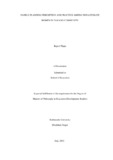
Please use this identifier to cite or link to this item:
https://hdl.handle.net/20.500.14301/185| Title: | FAMILY PLANNING PERCEPTION AND PRACTICE AMONG NON-LITERATE WOMEN IN TAMANG COMMUNITY |
| Authors: | Thapa, Rajani |
| Citation: | Thapa,R.(2012).Family planning perception and practice among non literate women in Tamang community |
| Issue Date: | Jul-2012 |
| School: | SOED |
| Department: | DODE |
| Level: | M.Phil. |
| Program: | MPhil in Development Studies |
| Abstract: | Women reproductive right is one of the emerging phenomenon in Nepal as in all developing countries. Though it has been growing with the implementation of family planning program, majority of Nepali women are not well familiar with their reproductive rights which consists to women’s reproductive and sexual health. One of its concerned area is family planning and women’s access to related services. Therefore this study was undertaken with the prime purpose of exploring Tamanag women’s perception and practices toward family planning, Tamang socio-cultural roles to family planning practices and the role of education to change their perception towards family planning practices. I conducted this study in Tamang community of Khoria Gaun in Changu Narayan VDC, Bhaktapur district in Nepal and took 4 non literate Tamang women as the participants who have experiences of using family planning devices. Mainly staying within interpretative approach; I followed the qualitative research method with support of informal conversational interview and observation tools for collecting necessary information as per my research questions. I employed with many relevant sociological perspectives while interpreting and analyzing data. Especially, I injected Jurgen Habermas’ “Theory of communicative action” to explain and interpret the study. I reviewed many empirical studies, policies, plans and strategies related to family planning so that I could easily reach to my destination of this study. I found that my respondents were also familiar about family planning and its different means. They have practiced family planning methods as their own understanding and local context. They have generated knowledge of family planning by communicating and interacting with friends, service providers and development workers. Participants have taken family planning devices as means of ‘birth control’ and have experiences of side effects of using different FP methods. Actually, participants have faced different kinds of physical and mental problems as well as unintended pregnancy while using FP methods. Similarly, the misunderstanding and rumors about family planning devices and method have created uncomfortable environment to use family planning services among user groups. The socio-cultural practices of the Tamang community were found very crucial in determining the family planning behavior of women. Tamang religion, trend of marriage, family system, power of decision making, preference to son were directly or indirectly influence women’s practice of family planning. Generally, the trend of early marriage practice in Tamang community was one of the major causes which supported to increase the fertility power and hence in delivering large number of children. Similarly, the gender role plays a strong difference between Tamang woman and man for practicing FP devices. Tamang women’s economic dependency on their husband is resulted in male control in family planning behavior of women. However, it was also found that husbands are not very concerned to apply the method themselves but have given freedom to choose preferable methods of family planning to their wives. Analyzing to educational contribution, participants have gained family planning education through way of informal learning. Participants learn about family planning practice by communicating and interacting about the experiences of family planning to each others. Thus, they have been learning family planning education from ‘learning by doing’ approach. At present, Government organization (GOs), NGOs, INGOs and local bodies are working unanimously with focus on family planning program. I found that participants were becoming economically active in saving and credit programs under mother’s group of the same community. It might be the outcome of the presence of development workers in that community. Thus, communications between local people and development activists have supported women to become more conscious on family planning related issues. All these show that education or learning through formal, non formal or informal system helped to enhance economic empowerment of Tamnag women so as to change their perception and practice of FP. Access to and participation in education, economic empowerment and supportive socio-cultural practices has thus direct implication in women’s reproductive health as well as in ensuring their reproductive right. |
| URI: | https://hdl.handle.net/20.500.14301/185 |
| Appears in Collections: | Dissertations |
Files in This Item:
| File | Description | Size | Format | |
|---|---|---|---|---|
| MPhil Dissertation - RAJANI.pdf | 1.09 MB | Adobe PDF |  View/Open |
Items in DSpace are protected by copyright, with all rights reserved, unless otherwise indicated.